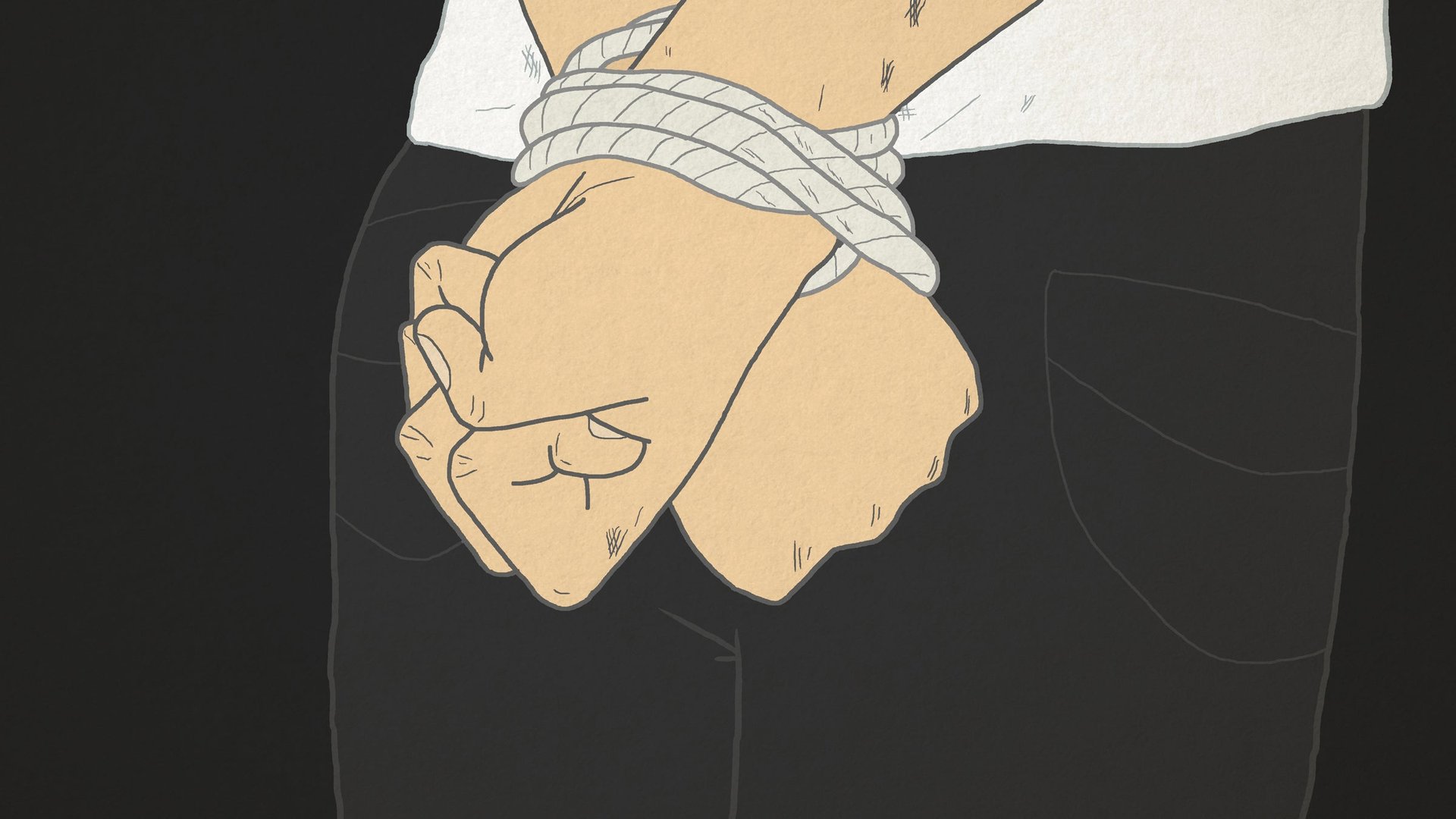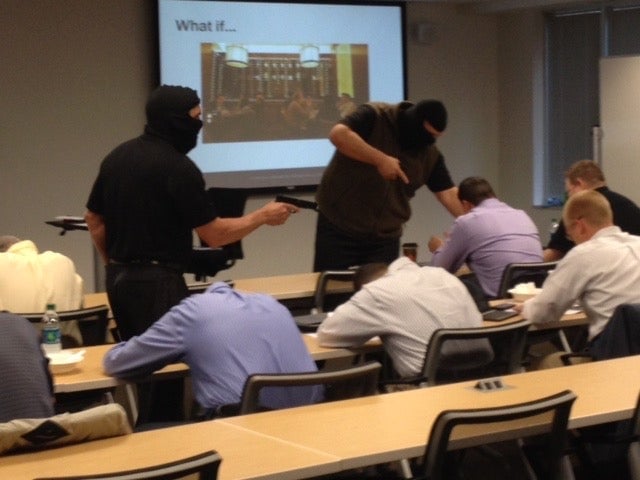I went to a kidnapping survival camp for business executives
On a Tuesday, I was kidnapped. Men in ski masks burst into the room and yelled for us to put our heads on the table. They demanded our wallets. I was so startled that I couldn’t find my mine.


On a Tuesday, I was kidnapped. Men in ski masks burst into the room and yelled for us to put our heads on the table. They demanded our wallets. I was so startled that I couldn’t find my mine.
It was, of course, in my back pocket. Despite the stress of the situation—or, perhaps, because of it—I chuckled at the irony.
“Don’t laugh! Do you want to die today?” growled the hooded perp. I put my face very flat onto the table. I tried to control my breathing.
“Who here is an American? Faces down, hands up!” That’s when I laughed, out loud this time—because we were in an office park in Reston, Virginia, and everyone was an American. I was in a simulation exercise, part of a two-day course in high-risk travel safety. Even though the simulation called for us to be in Mexico City, the men were shouting in comically plain English. I cackled as the exercise ended.
Inside the Center for Personal Protection and Safety
There are, it sometimes seems, no normal businesses in Northern Virginia. The Beltway lexicon is full of organizations whose anodyne appellations belie their extraordinary nature: There’s little “general” about the fearsomely customized weaponry General Dynamics makes for the Pentagon, for example, and in that tradition, the Center for Personal Protection and Safety (CPPS) has a boring name that only hints at the scope of its operation. What it does is train you to survive anything.
From simulated workplace shootings to advice on kidnapping, the CPPS prepares private citizens—not spies or soldiers—to make it through worst-case scenarios.
Travel safety preparedness makes up a quarter to a third of the business. According to estimates by US insurer AIG, about 40,000 kidnap-and-ransom cases involving business travelers are reported every year, and CPPS CEO Randy Spivey estimates that his clients include “about 60% of the Fortune 100.”
At about 15 employees and 15 contractors, the CPPS is a small operation. But since it launched in the aftermath of 9/11, hundreds of thousands of Americans have viewed its instructional travel safety videos. Every year, says Spivey, 2,000 to 3,000 students attend its safety training workshops.
Kidnapped in “Venezuela”
I attended one workshop to report for Quartz. Outside the main classroom—a fluorescently-lit cavern with flanking projector screens—an eerie triptych showed the figures of Americans menaced abroad: abducted at gunpoint, chained to radiators, in a ransom video. “Confidence,” according to the CPPS website banner, “starts here.”
Leading the session were Spivey and CCO Roger Aldrich, in matching CPPS Nike golf shirts. Both used to wear a different uniform; they served in the Joint Personnel Recovery Agency, the military group tasked with debriefing Americans who are captured abroad. Spivey was on site with the JPRA when, in 2001, an Air Force crew returned to America after being detained by China.
My classmates served as a neat cross section of the travel safety industry’s market segments. Fellow attendees included an ex-military fellow running executive protection for a prestigious international bank; a travel and operations professional, in-house with a company expanding into foreign markets; a cautious retiree traveling abroad for the first time; and, of course, the guy in the back with a cowboy hat and delusions of Taken.
A large portion of the course covered cursory travel tips: Carry a decoy wallet; don’t display wealth ostentatiously; pay attention to your surroundings; pack a “go” bag for emergencies. But precautions only reduce the chances of something going wrong. They can’t prevent the possibility altogether.
That’s when practice comes in handy.
In one training session, I was “kidnapped in Venezuela” with a coworker. My assailant, played by Aldrich, had targeted Americans: he was angry at the US government because his brother had been killed in a skirmish at the border.

A burlap sack was thrown over my head and we were marched down the hall to a windowless room where Aldrich awaited. I’m over six feet tall, much taller than Aldrich, but having a gun pointed at me—rubber or otherwise—made me feel very small indeed.
In the next five minutes, he lobbed a barrage of questions at me. Searching for a conversational foothold, I told him my meager income, that I volunteered to raise climate change awareness, and that I had an idea for him. I was trying to empathize, but I could tell I was overthinking things. He got more and more agitated with me—but that’s because I’d gotten everything wrong.
After I sat back down in the classroom, the instructors walked us through our mistakes as they peppered the class with questions. Had I thought about how I sounded to my captor? To his ears, I’d told him I couldn’t garner him the return my colleague would bring, that his cause wasn’t important to me, and that I was smarter than him. Of course he was angry.
Here’s what I should have known, according to CPPS:
- The most dangerous part of a crisis is its beginning, when volatility rules. In general, the longer you’re held a hostage, the better your chances of surviving (though danger can spike if negotiations are tense or during fraught exit situations).
- The best strategy for surviving the beginning: Stay calm. If you’re nervous about speaking with your adversary, pick a spot on their face to concentrate on. Avoid sticking out, whether by standing alone or by making a sudden move.
- Be a person, not an object. Find a connection with your captor. Family is one of the only safe topics for discussion (as at the dinner table, never money, religion, or politics). Highlight physical ailments in a respectful, rather than familiar, tone, and be persistent without being a pest.
- Be valuable. Remember that you are almost always most valuable to a kidnapper if you are alive, and find subtle ways to remind them of that value, which could come down to income, kinship, or connections.
- Don’t lie if there’s any chance you’ll get caught. Remember that if you’re being questioned, you’re also likely being Googled. When you have to talk, be general rather than specific.
- Ask for a representative from the US embassy (if held by government). Travelers in the 190 countries party to the Vienna Convention are guaranteed a visit from an embassy representative, even if they’re in custody, but this diplomatic safeguard isn’t the golden ticket it was meant to be. An official outside of a capital area is unlikely to be familiar with the law; do you think every highway patrolman in America would be?
If I’d known all of this, I might have done what my pretend coworker did. She mentioned that she, too, had lost someone. She stayed out of the politics, and talked up the fact that she was important to her corporation, which would surely pay for her release. Even these little tips would help her stay safe in a real capture scenario.
And maybe that explains why terrifying spectacles are so common here at CPPS: It’s how you get people to remember the little things. “We’re not peddling fear,” said Spivey. “We’re dismantling fear. Don’t be paranoid, but don’t be oblivious.”
Why corporate clients
Individuals might be driven to attend the CPPS by fear; businesses, on the other hand, are required, pursuant to their obligations to employees under OSHA’s “duty-of-care” clause, to provide a safe travel experience—consistent with “an emerging norm under customary international law.”
Hot spots for kidnapping today include Central America, South America, and West Africa, and many are non-terroristic “express kidnappings,” executed for profit. Notably, high concentrations of kidnappings are observed in areas where multinational companies are forging ahead with oil and gas exploration, like Nigeria—often with destabilizing effects on local economy and society.
As corporations look to solve the bevy of concerns brought on by cross-border business, spending on international business travel is expected to grow 8.6% this year. “Workplace health and safety laws impose a duty of care on employers as to all their staff worldwide—overseas business travelers, expatriates, and local workers alike,” writes Donald C. Dowling, Jr., an international employment lawyer with K&L Gates. The obligation is greatest, he continues, when it comes to business travelers.
Spivey told me a Fortune 10 company had recently been sued by an executive who’d been threatened in Mexico, a kidnapping hotspot, and felt the corporation hadn’t done enough to protect him.
America’s travel safety industry
Finding data on the size of the travel safety market is tough because, as Spivey puts it, “No one else does this.” Maybe no one else does exactly what CPPS does, but, the safety coaching industry is one with a high level of differentiation.
Among the similar alternatives: You can take a $900 three-day kidnap prevention course at tactically-minded Risks Incorporated, who also teach sniper training; a £750 ($1177) travel safety class at UK-based Objective Travel Safety, who also offer a specialized course for drivers in the Mongol Rally; or a £1980 ($3109) kidnap-and-ransom course with ARC Training. When things are really dicey, Global Rescue offers 45-day Medical & Security packages that can cover emergency evacuations—for only $655.
(Risks Incorporated, a competitor that offers more intense security trainings, has also been linked to torture in Haiti and Mexico, while a 2009 ProPublica investigation links Aldrich and Spivey of CPPS to an outfit that advised the CIA on waterboarding.)
There are plenty of free educational resources, too, available from the Department of State’s Overseas Security Advisory Council, or you can just Google them. But the perk of a live course: rubber guns waved about by ex-soldiers. That, goes the pedagogy at CPPS, is exactly what makes this work: Teach under stress, in a simulation, and the lesson is more likely to stick.
I do feel better equipped to deal with being kidnapped than I did before the course. A kidnapping—even a fake one—is an indelible experience.
The problem with “Trashcanistan”
But it’s hard to square certain teachings with my lived enjoyment of travel: helpful bus drivers in Bolivia; effusive Indian greetings; a summer spent punting on the Cam. At the sparse, fluorescently-lit CPPS, instructors tended toward hyperbole, positing once: “You don’t know if there’s some Islamic group in Latin America.”
As the two-day training wore on, anecdotes were increasingly disconnected from reasonable travel plans: Our guest speaker was a guy who tried to start a coup against Noriega, and we watched videos by an evangelist who was captured in theocratic Iran. “Trashcanistan,” an apparent sobriquet for Afghanistan, became a stand-in term for “your (scary) travel destination.”
That’s the source of my unease. Referring to foreign places with demeaning, garbage-related epithets is not a good habit for Americans to be in, if we want the world to be a better place. And CPPS teaching methods—while addressing legitimate worries—doubtlessly reinforce stereotypes as long as they rely on extreme examples. It would be naive to think cultural arrogance doesn’t ultimately rebound to hurt travelers.
“It’s a crazy world,” Spivey says. As long as people think so, he will have a business.